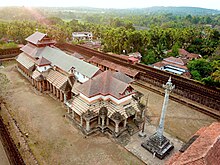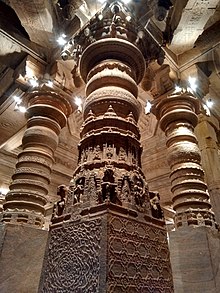

| Saavira Kambada Basadi | |
|---|---|
Tribhuvana Tilaka Cūḍāmaṇi
| |

Sāvira Kambada Temple, Karnataka
| |
| Religion | |
| Affiliation | Jainism |
| Deity | Chandraprabhu |
| Festivals | Mahavir Jayanti |
| Governing body | Shri Moodabidri Jain Matha |
| Bhattaraka | Charukeerti Panditacharya Varya |
| Location | |
| Location | Moodabidri, Karnataka |
| Geographic coordinates | 13°04′27.3″N 74°59′51.5″E / 13.074250°N 74.997639°E / 13.074250; 74.997639 |
| Architecture | |
| Creator | Devaraya Wodeyar |
| Date established | 1430 AD |
| Temple(s) | 18 |
| Website | |
| www | |
| Part of a serieson |
| Jainism |
|---|
 |
|
|
|
Ethics
Ethics of Jainism
|
|
Jain prayers |
|
Major figures |
|
Major sects |
|
|
|
Festivals |
|
Pilgrimages |
|
Other |
|
|
Saavira Kambada Temple (Sāvira Kambada Basadi) or Tribhuvana Tilaka Cūḍāmaṇi), is a basadiorJain temple noted for its 1000 pillars in Moodabidri, Karnataka, India. The temple is also known as "Chandranatha Temple" since it honours the tirthankara Chandraprabha, whose eight-foot idol is worshipped in the shrine.[1][2]
The town of Moodabidri is noted for its 18 Jain temples, but Saavira Kambada Temple is considered the finest among them.[3][4] The temple is considered an architectural wonder and is a major attraction of Moodabidri.
The Basadi was built by the local chieftain, Devaraya Wodeyar in 1430 and took 31 years to complete,[5] additions to temples were made in 1962. The shrine has a 50 feet tall monolith manasthambha erected by Karkala Bhairava Queen Nagala Devi.[6][7]

The temple is considered an architectural wonder.[8] The temple is full of elaborate sculptures and decoration. The doorway of the temple has intricate carvings and is enclosed with ornate walls. The massive pillars of the temple are carved to resemble an octagonal wooden log with one baring inscription.[9][10][11] The 1000 pillars with exquisite detail, support the temple and no two pillars are alike.[12] The sloping roof of veranda are made of wood coated with copper tiles resembling the temples of Nepal. The temple complex has seven mandapas supported by beautifully carved pillars built in the Vijayanagara style.[13] The main mandapa of the temple consists of two interconnected column halls.[14] The fourth mandapa houses a sculpture of Bhairavadevi.[7] The top two storeys are carved in wood and the lowest one in stone.[6]
The hall interiors are massive, with elaborately decorated columns and a door flanked by two protector deities. The wooden panels inside the temples have carvings of Tirthankara flanked by elephants, guardian deities and female attendants holding flowers. Several bronze Jain idols in ornated frames are placed inside the garbhagriha.[15] The 8 ft idol of Chandranatha Swami made of panchadhatu present in the garbha griha.[6] The temple are built similar to temples in Nepal. The interiors of the temple are richly and variedly carved. A large number of tombs of Jain monks are present near the temple premise. The manastambha in front of the temple is noteworthy.[16] The pillars inside the hall bear carvings of dragon and giraffe resulting from the influence of trade with China in 15th century.[17] The image of Nandishwar-dweep dated 16th century is notable.[18]
Saavira Kambada Basadi along with Shravanabelagola, Kamal Basadi and Brahma Jinalaya are considerest the most important Jain centers in Karnataka.[19][20]
Guru basadi is the earliest of the Jain monuments built in 714 AD. A black stone idol of Parshwanatha, about 3.5 metres (11 ft) tall, is installed in the sanctum of this basadi.[21] The temples also house 12th-century Jain palm leaf manuscripts known as ‘Dhavala texts’ are preserved. These texts were brought from shravanabelagola to here during the Mughal invasion. This basadi is also called Siddantha Basadi and Hale Basadi.[3]
Moodabidri is noted for its 18 Jain Temples, some mentioned as follows:[22]
There is a matha at Moodabidri responsible for the upkeep and maintenance of temples in Moodabidri.[23] It is known as the Jain Varanasi of the South.[21][24]
Abhaṭṭāraka seat exists at Moodabidri responsible for administering the 18 temples at Moodabidri and the other temples in the surrounding areas. The name given to the bhaṭṭāraka of Moodabidri is Charukeerthi.[23][25]
The temple is listed as one of the temples in the Fodor's "India's Jain Temples Are Incredible Architectural Marvels" series.[26]
![]() Media related to 1000 Pillar Temple (Moodabidri) at Wikimedia Commons
Media related to 1000 Pillar Temple (Moodabidri) at Wikimedia Commons
|
| |
|---|---|
See also : Jain temples in North America | |
| Bihar |
|
| Delhi |
|
| Gujarat |
|
| Jharkhand |
|
| Karnataka |
|
| Kerala |
|
| Madhya Pradesh |
|
| Maharashtra |
|
| Nagaland |
|
| Odisha |
|
| Rajasthan |
|
| Tamil Nadu |
|
| Telangana |
|
| Uttar Pradesh |
|
| West Bengal |
|
| |
|
| |||||
|---|---|---|---|---|---|
| Gods |
| ||||
| Philosophy |
| ||||
| Branches |
| ||||
| Practices |
| ||||
| Literature |
| ||||
| Symbols |
| ||||
| Ascetics |
| ||||
| Scholars |
| ||||
| Community |
| ||||
| Jainism in |
| ||||
| Jainism and |
| ||||
| Dynasties and empires |
| ||||
| Related |
| ||||
| Lists |
| ||||
| Navboxes |
| ||||